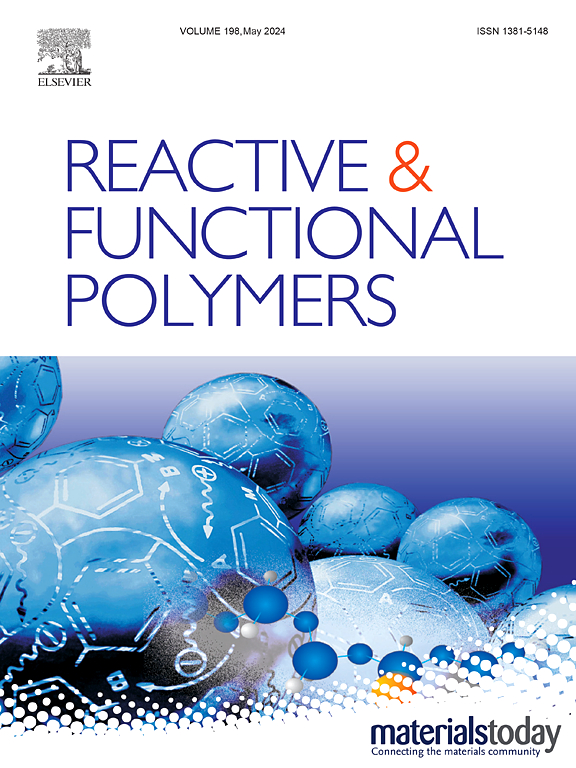Molecular mobility and calorimetric investigation in renewable polymeric systems based on polylactide blocks in situ built on Pluronic (poloxamer 188)
IF 5.1
3区 工程技术
Q1 CHEMISTRY, APPLIED
引用次数: 0
Abstract
In this work, we study a newly synthesized series of renewable block copolymers based on poly(lactic acid), PLA, blocks built in situ onto the two terminal sites of pluronic at quite small amounts (poloxamer 188, 0.05–0.20 wt%), i.e., PLA-b-Pluronic-b-PLA. The investigation involves mainly calorimetry and dielectric spectroscopy, supplemented by other techniques for the structure. The local and segmental dynamics mapping for the said systems is performed here for the first time. The direct effects of the copolymer structure on the thermodynamical properties are assessed mainly in the amorphous PLA state. Useful conclusions are obtained by directly comparing with neat linear PLAs of various molecular weights, Mn. Interestingly, Pluronic seems to play a co-initiator role within the ring opening polymerization of lactides. The successful copolymer synthesis is partially confirmed here by the systematic decrease of the copolymer chain lengths (Mn), the corresponding acceleration of molecular mobility (Tg drop) and the decreasing fragility, with the increasing of the amount of Pluronic. Compatible with the above results are also the recorded effects on crystallizability of PLA, being mainly suppressed in the PLA/Pluronic systems, in terms of both nucleation and crystalline fraction. The dominant parameters on molecular dynamics were the Mn, the alternations in the free volume and chain-chain associations, in addition to the existence of dynamical heterogeneities in the copolymers, always comparing with neat PLAs of various Mn [Polymer 305 (2024) 127177]. The PLA/Pluronic systems are envisaged for biomedical application, as are considered to exhibit the so-called thermo-responsive transition in aqueous environments. In this frame, the plethora of alternations recorded, herein, e.g., on the Tg and semi-crystallinity of PLA/Pluronic, comparing with neat PLAs, set these systems interesting for further study regarding the applications.

基于Pluronic (poloxam188)原位聚丙交酯嵌段的可再生聚合物体系的分子迁移率和量热研究
在这项工作中,我们研究了新合成的一系列基于聚乳酸的可再生嵌段共聚物,PLA,以相当小的量(poloxamer 188, 0.05-0.20 wt%)原位构建在pluronic的两个末端,即PLA-b- pluronic -b-PLA。研究主要涉及量热法和介电光谱法,并辅以其他结构技术。本文首次对上述系统进行局部和分段动态映射。共聚物结构对其热力学性能的直接影响主要在非晶态下进行。通过直接比较不同分子量的整齐线性pla得到了有用的结论。有趣的是,Pluronic似乎在丙交酯开环聚合中起着共同引发剂的作用。随着Pluronic用量的增加,共聚物的链长(Mn)不断减小,分子迁移率(Tg)相应加快,易损性降低,这部分证实了共聚物的成功合成。与上述结果相一致的是,记录的对PLA结晶性的影响,主要是在PLA/Pluronic体系中,在成核和结晶分数方面受到抑制。分子动力学的主要参数是Mn,自由体积和链链结合的变化,以及共聚物中存在的动力学异质性,总是与各种Mn的纯pla进行比较[Polymer 305(2024) 127177]。PLA/Pluronic系统被设想用于生物医学应用,因为被认为在水环境中表现出所谓的热响应转变。在这个框架中,这里记录了大量的变化,例如,与纯PLA相比,PLA/Pluronic的Tg和半结晶度,使这些系统对进一步的应用研究很感兴趣。
本文章由计算机程序翻译,如有差异,请以英文原文为准。
求助全文
约1分钟内获得全文
求助全文
来源期刊

Reactive & Functional Polymers
工程技术-高分子科学
CiteScore
8.90
自引率
5.90%
发文量
259
审稿时长
27 days
期刊介绍:
Reactive & Functional Polymers provides a forum to disseminate original ideas, concepts and developments in the science and technology of polymers with functional groups, which impart specific chemical reactivity or physical, chemical, structural, biological, and pharmacological functionality. The scope covers organic polymers, acting for instance as reagents, catalysts, templates, ion-exchangers, selective sorbents, chelating or antimicrobial agents, drug carriers, sensors, membranes, and hydrogels. This also includes reactive cross-linkable prepolymers and high-performance thermosetting polymers, natural or degradable polymers, conducting polymers, and porous polymers.
Original research articles must contain thorough molecular and material characterization data on synthesis of the above polymers in combination with their applications. Applications include but are not limited to catalysis, water or effluent treatment, separations and recovery, electronics and information storage, energy conversion, encapsulation, or adhesion.
 求助内容:
求助内容: 应助结果提醒方式:
应助结果提醒方式:


